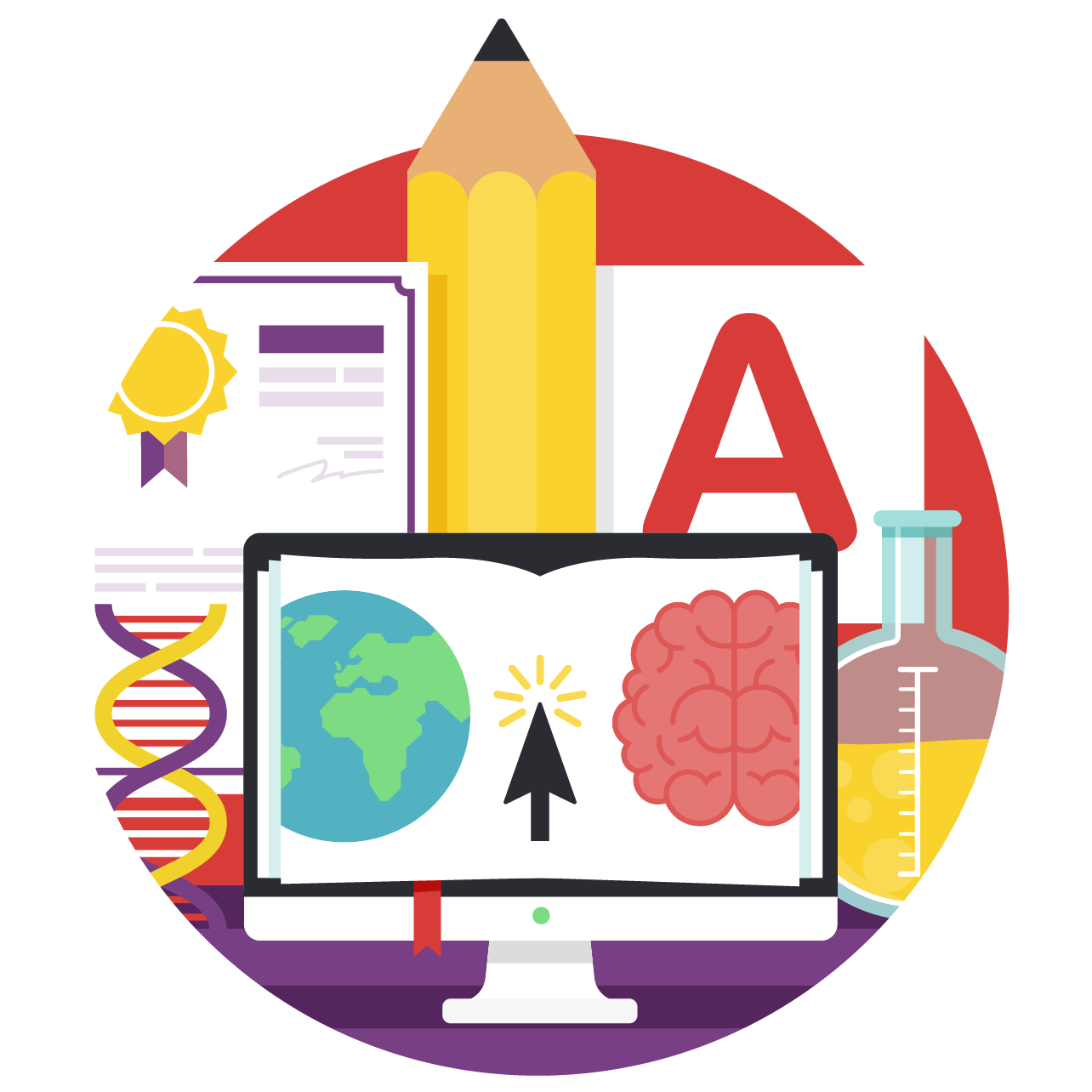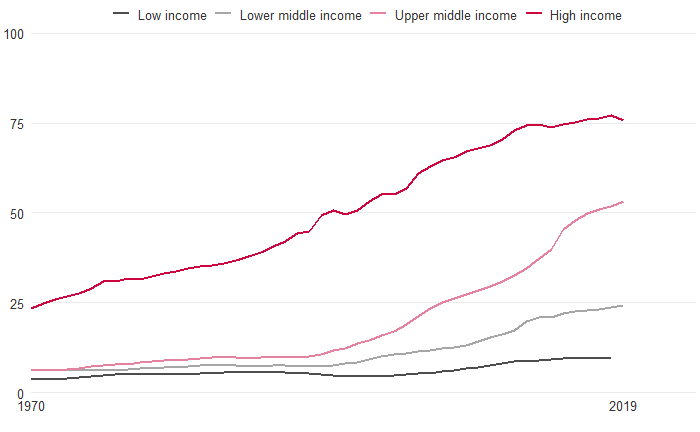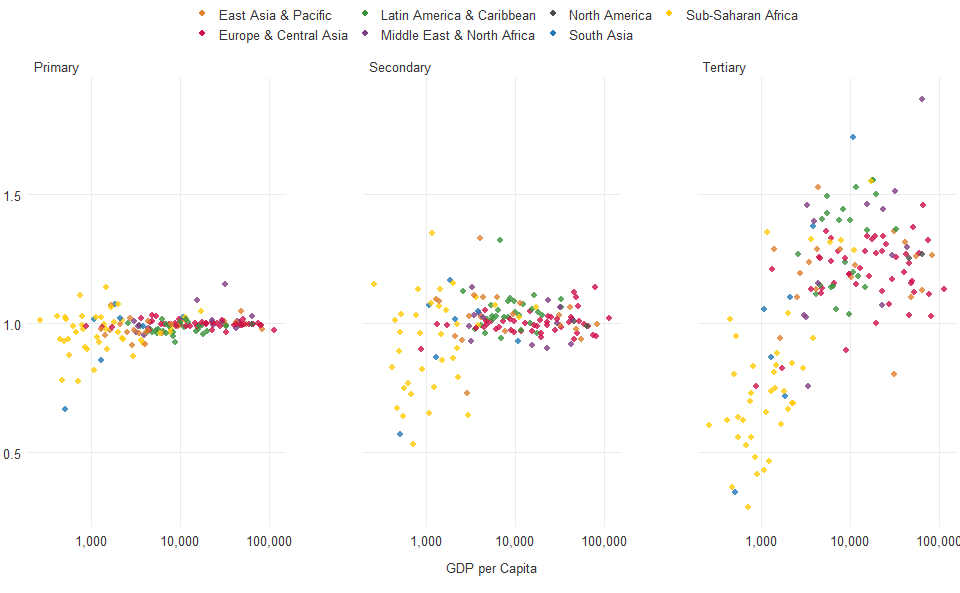


Quality education
Learning poverty: children's education in crisis
Over the past 50 years primary school enrollment has been nearly universal in high-income countries. While low- and middle-income countries lagged far behind in 1970, they have since made substantial progress towards universal primary enrollment, in the context of the Millennium Development Goals and later as part of the SDGs. In 2018 nearly 90 percent of primary school–age children in low- and middle-income economies were enrolled in school. But despite high enrollment rates, many students are not learning.
Low- and middle-income countries are closing the gap with high-income countries in school enrollment rates
Net primary school enrollment, by income group (%)
Learning outcomes are usually measured by assessments carried out among children enrolled in school, though the assessments differ across countries. The coverage of learning assessments (by age group and subject matter) also differs across countries. In addition, since these assessments are given in schools, they exclude children who do not attend school. All of this makes it challenging to compare learning outcomes across countries. Under the leadership of the United Nations Institute for Statistics (UIS), the SDG 4 Technical Cooperation Group agreed on a shared understanding on how to compare proficiency levels across different learning assessments.
Building on this work, UIS and the World Bank’s new learning poverty indicator combines schooling and learning by summing the proportion of students below minimum reading proficiency and the proportion of out-of-school children.
The bivariate nature of this indicator assumes that education systems have two important functions: keeping children in school and making sure that they are learning. COVID-19 school closures have shown that schools play a critical set of functions to protect and improve children’s health and well-being, such as safety, nutrition, socialization, facilitate parents' labor market participation, and in society can help build social cohesion, democracy and peace. These complementary functions signal an intrinsic value in schooling over and above learning and highlight its relevance for measuring learning poverty.
Learning poverty focuses on reading skills because reading is assessed more widely than other subjects and is fundamental to accelerating other forms of learning throughout an individual’s life. We explore how quality education can be measured through the lens of learning poverty.
Learning poverty in low- and middle-income countries varies by region
Share of children at the end of primary school age (ages 10-14), by learning category, 2015 (%)
Notes: Learning poverty is presented only for low- and middle-income countries.
Source: World Bank. 2019. Ending Learning Poverty: What Will It Take? Washington, DC.
Half the children in low- and middle-income countries are unable to read and understand a simple text by age 10. These children are considered learning poor.
Learning poor refers to children at the end of primary school (ages 10-14) who read at below the minimum proficiency level and children out of school who are assumed to not read proficiently. About 10 percent of these children are out of school, and another 40 percent are not learning while in school.
Learning poverty rates exceed 50 percent in four regions.
The challenge faced by Sub-Saharan Africa is particularly acute.
Nine of 10 children in Sub-Saharan Africa—more than 100 million—are learning poor.
Sub-Saharan Africa had the highest rate of out-of-school children in 2018: 24 percent, or 30 million children.
In addition, 80 percent of children in school—77 million—did not acquire minimum reading proficiency.
Another 100 million children in South Asia—6 of 10—are learning poor.
An estimated 89 million of them are school-going children who are unable to read at the age of 10. Although this is higher than the number in Sub-Saharan Africa (77 million), the share of children not learning to read is lower: 55 percent compared with 80 percent in Sub-Saharan Africa.
As in other regions, each country in South Asia exhibits a distinct pattern in education outcomes. Disaggregating learning poverty into its components makes it easier to understand the challenges faced by each country.
Although the share of children out of school is low in most countries, the share of children in school who are learning below minimum proficiency is concerning
Notes: The measure is based on children who are at the end of primary school (ages 10-14). The size of the bubble is proportional to the number of these children in each country.
Source: World Bank. 2019. Ending Learning Poverty: What Will It Take? Washington, DC.
Afghanistan and Pakistan face the most serious challenges. In both the shares of children out of school (50 percent in Afghanistan and 27 percent in Pakistan) and of school-going children below minimum reading proficiency (44 percent in Afghanistan and 47 percent in Pakistan) are above the average.
In contrast, nearly all children attend school in India and Bangladesh. However, in both countries more than half of children suffer from learning poverty because they read below the minimum proficiency level while in school.
Sri Lanka, with a learning poverty rate of 15 percent, performs better than other South Asian countries. Sri Lanka has near-universal school enrollment, and more than 85 percent of students exceed the minimum reading proficiency level.
To explore data by region, hover over each region label.
The learning poverty measure reveals the poor learning outcomes globally. Ensuring that children attend school is essential but not sufficient to achieve the SDG goal of quality education. The large number of students who read below the minimum proficiency level suggests weaknesses in education systems around the world. Improving teaching through effective teacher training, a conscious shift to “teaching at the right level,” and access to reading material for students are among the important steps for raising learning outcomes. For sustained improvements in learning outcomes, countries need to go beyond teaching techniques and employ a holistic approach to reforming the education system. This includes boosting investment in early childhood development, shifting to instruction in children’s mother tongues, and ensuring accountability at every level.
Learning crisis in a pandemic
The COVID-19 pandemic is worsening the learning crisis. At the peak of the pandemic, almost 200 countries closed schools. Sustained school closure could result in poorer learning outcomes in the short term and in the longer term could adversely affect skill accumulation and earnings due to higher dropout rates or poorer socioeconomic conditions in the households children grow up in.
Before the COVID-19 pandemic the share of children unable to read proficiently was on track for a marginal improvement by 2030 (from 53 percent to 43 percent). However, new projections since the school closures indicate that learning poverty rates could worsen between 2020 and 2021. Because the impacts of COVID-19 cannot be fully known at this time, different scenarios are considered: an optimistic scenario, an intermediate scenario, and a pessimistic scenario. Under a pessimistic scenario of no remediation and low effectiveness in mitigating the impacts, learning poverty globally could increase by more than 10 percentage points, from 52.7 percent to 63.2 percent. The largest impacts are expected in South Asia, followed by Latin America and the Caribbean. Sub-Saharan Africa would experience a small impact on the rate of learning poverty because its already very high rate has little room to increase. In fact, measures of learning poverty that factor in how far students are from reaching minimum proficiency in reading suggest that students in Sub-Saharan Africa are suffering some of the worst learning losses.
Learning poverty will increase in all regions due to the COVID-19 pandemic
Current and simulated learning poverty (%)
Note: Learning poverty is presented only for low- and middle-income countries.
Source: Azevedo, Joao Pedro. 2020. “Learning Poverty: Measures and Simulations.” Policy Research Working Paper 9446. World Bank, Washington, DC.
Prior to the COVID-19 pandemic, under an optimistic scenario of accelerated commitment and progress, countries could have halved the learning poverty rate by 2030. New projections suggest that because of the pandemic it will take until 2034 to do so. Under a more pessimistic scenario assuming “business as usual,” with countries making improvements at their current pace, it would take until around 2055.
Scenarios for learning poverty rates
Learning poverty, observed and simulations (%)
Source: Azevedo, Joao Pedro, Amer Hasan, Diana Goldemberg, Syedah Aroob Iqbal, and Koen Geven. 2020. “Simulating the Potential Impacts of COVID-19 School Closures on Schooling and Learning Outcomes: A Set of Global Estimates.” Policy Research Working Paper 9284. World Bank, Washington, DC.
In many countries schools do more than educate. They also provide meals to children through school feeding programs. At the peak of the pandemic in April 2020, the World Food Programme estimated that nearly 370 million children were unable to receive school meals due to closures. Seven months later, 70 percent of these children still lack access to school meals.
370 million children left without school meals at the peak of the pandemic
Many of the children who benefit from school meal programs belong to vulnerable households and rely on the meals for consistent nutrition. Due to the COVID-19 pandemic, the incomes of many such households are at risk, and without school meals food insecurity could worsen (hampering the achievement of SDG 2 on ending hunger). During sustained periods of food insecurity, children can become chronically undernourished, which could have long-term effects on their growth and impair their ability to learn and contribute to the workforce.
Previous crises have shown that school closures and similar shocks can lead to lower learning, higher dropout rates, and other negative outcomes for children. The effects tend to fall disproportionately on socioeconomically disadvantaged children.
During the 2014 Ebola outbreak the government of Sierra Leone closed all schools for the entire 2014–15 academic year. A recent study examining the impact of the school closures on young girls (aged 12-17) found large adverse effects for girls in the villages most affected by the outbreak.
School closures during the Ebola outbreak led to poorer schooling, literacy, and social outcomes
Share of children enrolled or becoming pregnant (%), numeracy or literacy scores (0–100)
Source: Bandiera, Oriana, Niklas Buehren, Markus Goldstein, Imran Rasul, and Andrea Smurra. 2018. “The Economic Lives of Young Women in the Time of Ebola: Lessons from an Empowerment Program.” World Bank, Washington, DC.
School enrollment dropped by more than 15 percentage points since the outbreak, pregnancy rates doubled, numeracy fell by 7 percentage points, and literacy was halved.
Encouragingly, the authors found that policy action can mitigate the negative outcomes. An intervention providing meeting places and life and vocational skills training for girls reversed many of the losses.
A 7.6 magnitude earthquake in the Kashmir region of Pakistan in 2005 caused widespread destruction and loss of life. Although households in the vicinity of the earthquake received aid, life was substantially disrupted in the short term.
Learning gaps by socioeconomic status were more apparent near the earthquake’s fault line, where schools were closed for longer
Student achievement score (difference from the average student)
Source: Andrabi, T., B. Daniels, and J. Das, J. 2020. “Human Capital Accumulation and Disasters: Evidence from the Pakistan Earthquake of 2005.” RISE Working Paper 20/039.
In addition, inequality in learning across children increased. Children of mothers who completed primary school were generally protected from learning losses, while children with mothers who completed less than primary school suffered serious losses. Similar learning disparities could emerge after the COVID-19 pandemic.
Prior to the COVID-19 pandemic, the world was not on track to meet the SDG 4 targets, and the COVID-19 pandemic has further disrupted progress. While inclusive and equitable quality education has yet to be achieved, the past 50 years have shown that progress can be made. Countries have, for example, raised student enrollment substantially. A swift policy response will be needed to respond to learning losses due to the pandemic, and countries should commit to building a more equitable and resilient post-COVID education system.
Learn more about SDG 4: Quality education
Swipe for the next chart


Notes
- World Bank. World Development Indicators (SE.PRM.NENR) ↩
- Thanks to the Global Alliance to Monitor Learning (GAML) led by the UNESCO Institute of Statistics, there is a consensus of how these minimum standards for learning by early grade, primary and secondary education map into the scales of international, regional, and national learning assessments. One of the GAML process's biggest contributions was shifting the conversation from a common scale (requiring that all countries implemented the same assessment to have a global number) to a Global Proficiency Framework, which describes competencies that students should master to be considered proficient at each grade. This means different assessments of sufficient quality can be used as long as they can be benchmarked against this international standard. ↩
- World Bank. Country Learning Poverty Briefs. October 15, 2019. ↩
- World Bank. World Development Indicators (SE.PRM.NENR) ↩
- Data on learning poverty and its components are available for only five countries in South Asia. ↩
- World Bank. Ending Learning Poverty: A Target to Galvanize Action on Literacy. November 8, 2019. ↩
- Save Our Future. 2020. Averting an Education Catastrophe for the World’s Children. ↩
- World Food Programme. Global Monitoring of School Meals During COVID-19 School Closures. ↩
- Ibid. ↩
- Ibid. ↩
- Ibid. ↩
- Azevedo, Joao Pedro, Amer Hasan, Diana Goldemberg, Syedah Aroob Iqbal, and Koen Geven. 2020. “Simulating the Potential Impacts of COVID-19 School Closures on Schooling and Learning Outcomes: A Set of Global Estimates.” Policy Research Working Paper 9284. World Bank, Washington, DC. ↩
- World Food Programme. Global Monitoring of School Meals During COVID-19 School Closures. ↩
- World Bank. Working to End Hunger, Now and in the Future. October 16, 2014. ↩
- Bandiera, O., N. Buehren, M. P. Goldstein, I. Rasul, and A. Smurra. 2019. The Economic Lives of Young Women in the Time of Ebola: Lessons from an Empowerment Program. Washington, DC: World Bank. ↩
- Ibid. ↩
- Andrabi, T., B. Daniels, and J. Das. 2020. Human Capital Accumulation and Disasters: Evidence from the Pakistan Earthquake of 2005. RISE Working Paper 20/039. ↩